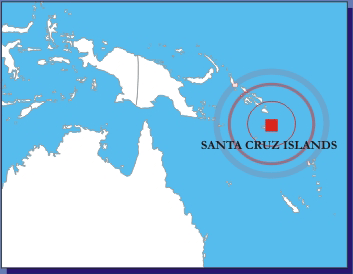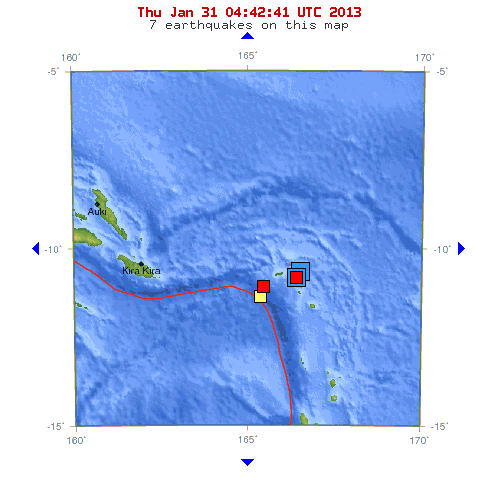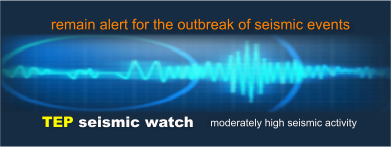6.2 magnitude earthquake strikes region of Santa Cruz Islands
January 31, 2013 – SANTA CRUZ ISLANDS – A deep 6.2 magnitude earthquake struck near the Santa Cruz Islands in the Pacific, about four hours after the region was rattled by a 6.0 magnitude earthquake. The 6.2 magnitude earthquake had a depth of 55.4 km (34.4 miles) with an epicenter of 60 km (37 miles) E of Lata, Solomon Islands. This is the third major earthquake to strike the planet in a 24 hour period. The planet is experiencing a heightened level of seismic activity following a record number of volcanoes across the globe exhibiting activity in the month of January. Today’s earthquake was followed in rapid succession by two 5.6 aftershocks, and a 5.0 magnitude earthquake in southern Sumatra, Indonesia, and a 4.5 aftershock in Atacama, Chile from the 6.8 magnitude earthquake. Seismic tension is also mounting on the Indo-Australian and Sunda plate near the region of Indonesia. –The Extinction Protocol
Strong 6.8 magnitude earthquake strikes northern Chile: 1 dead
 January 31, 2013 – CHILE – A magnitude-6.8 earthquake shook offices, toppled supermarket shelves and broke windows on Wednesday in north-central Chile, where people fled some buildings in panic. A 55-year-old woman in city of Atacama died of a heart attack, said Mayor Rafael Prohens, who attributed her death to fear during the quake. Authorities said that damage was limited and discounted the possibility of a tsunami. The U.S. Geological Survey originally reported the quake at 6.7, but later revised it upward. It struck at 4:15 p.m. (3:15 p.m.; 2015 GMT) and was centered 27 miles (44 kilometers) north of Vallenar, Chile. The quake shook the capital of Santiago, causing office buildings to sway, but was felt most powerfully in the north where state television showed images of scattered groceries at supermarket floors and broken windows at several homes in Vallenar, Copiapo and other nearby cities. Witnesses described people running from buildings into the streets in panic. Vallenar Mayor Cristian Tapia said telephone lines were jammed and some electricity lines were temporarily down but services were slowly returning. “The first half hour was really tough. We’re still having problems with telecommunications,” Tapia told state television. “Two walls collapsed. We’re evaluating ruptures at homes to find out if they’re still safe to live in.” But Chile’s Emergency Office, ONEMI, said no injuries were immediately reported and damage to infrastructure appear minimal. The oceanographic service discounted the possibility of a tsunami. “There’s no doubt the population in some places fled, following a culture of evacuation,’ Miguel Ortiz, national chief of the early alert center at ONEMI. Two lower intensity aftershocks were also reported. A devastating 8.8
January 31, 2013 – CHILE – A magnitude-6.8 earthquake shook offices, toppled supermarket shelves and broke windows on Wednesday in north-central Chile, where people fled some buildings in panic. A 55-year-old woman in city of Atacama died of a heart attack, said Mayor Rafael Prohens, who attributed her death to fear during the quake. Authorities said that damage was limited and discounted the possibility of a tsunami. The U.S. Geological Survey originally reported the quake at 6.7, but later revised it upward. It struck at 4:15 p.m. (3:15 p.m.; 2015 GMT) and was centered 27 miles (44 kilometers) north of Vallenar, Chile. The quake shook the capital of Santiago, causing office buildings to sway, but was felt most powerfully in the north where state television showed images of scattered groceries at supermarket floors and broken windows at several homes in Vallenar, Copiapo and other nearby cities. Witnesses described people running from buildings into the streets in panic. Vallenar Mayor Cristian Tapia said telephone lines were jammed and some electricity lines were temporarily down but services were slowly returning. “The first half hour was really tough. We’re still having problems with telecommunications,” Tapia told state television. “Two walls collapsed. We’re evaluating ruptures at homes to find out if they’re still safe to live in.” But Chile’s Emergency Office, ONEMI, said no injuries were immediately reported and damage to infrastructure appear minimal. The oceanographic service discounted the possibility of a tsunami. “There’s no doubt the population in some places fled, following a culture of evacuation,’ Miguel Ortiz, national chief of the early alert center at ONEMI. Two lower intensity aftershocks were also reported. A devastating 8.8 -magnitude quake and the tsunami it unleashed in 2010, killed 551 people, destroyed 220,000 homes and washed away docks, riverfronts and seaside resorts. The disaster cost Chile $30 billion, or 18 percent of its annual gross domestic product. Chile is one of the most earthquake-prone countries in the world. Just off Chile’s long coast, the Nazca tectonic plate plunges beneath the continent, pushing the Andes to ever-higher altitudes. The 2010 quake was so strong it changed time, shortening the Earth’s day slightly by changing the planet’s rotation. Less than 3 hours later, a powerful 6.0 magnitude earthquake struck the Santa Cruz Islands in the Pacific. The quake struck about 10 km (6.2) below the ocean floor and was followed by 4.6 magnitude aftershock. There were no reports of damage or injuries from the islands. -ABC
-magnitude quake and the tsunami it unleashed in 2010, killed 551 people, destroyed 220,000 homes and washed away docks, riverfronts and seaside resorts. The disaster cost Chile $30 billion, or 18 percent of its annual gross domestic product. Chile is one of the most earthquake-prone countries in the world. Just off Chile’s long coast, the Nazca tectonic plate plunges beneath the continent, pushing the Andes to ever-higher altitudes. The 2010 quake was so strong it changed time, shortening the Earth’s day slightly by changing the planet’s rotation. Less than 3 hours later, a powerful 6.0 magnitude earthquake struck the Santa Cruz Islands in the Pacific. The quake struck about 10 km (6.2) below the ocean floor and was followed by 4.6 magnitude aftershock. There were no reports of damage or injuries from the islands. -ABC
Posted in Civilizations unraveling, Earth Changes, Earth Watch, Earthquake Omens?, High-risk potential hazard zone,Human behavioral change after disaster, Lithosphere collapse & fisssure, Potential Earthchange hotspot, Seismic tremors, Signs of Magnetic Field weakening, Time - Event Acceleration, Volcano Watch 2 Comments



Brak komentarzy:
Prześlij komentarz